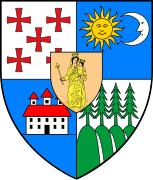Corund
Corund (Hungarian: Korond, Hungarian pronunciation: [ˈkorond] ) is a commune in Harghita County, Romania. It lies in the Székely Land, an ethno-cultural region in eastern Transylvania, in the "Salt Region" (Ținutul Sării or Sóvidék). Corund is famous for its pottery and ceramics.
Corund Korond | |
|---|---|
 | |
 Coat of arms | |
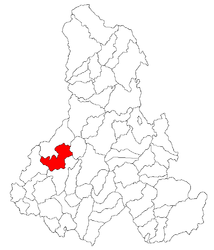 Location in Harghita County | |
 Corund Location in Romania | |
| Coordinates: 46°28′N 25°11′E | |
| Country | |
| County | Harghita |
| Government | |
| • Mayor | Mihály Katona (UDMR) |
| Area | 113.51 km2 (43.83 sq mi) |
| Population (2011)[1] | 6,135 |
| • Density | 54/km2 (140/sq mi) |
| Time zone | EET/EEST (UTC+2/+3) |
| Postal code | 537060 |
| Area code | +40 266 |
| Vehicle reg. | HR |
| Website | www.korond.ro |
Component villages
The commune is composed of five villages, the administrative center being Corund:
| In Romanian | In Hungarian |
|---|---|
| Atia | Atyha |
| Calonda | Kalonda |
| Corund | Korond |
| Fântâna Brazilor | Fenyőkút |
| Valea lui Pavel | Pálpataka |
Governance

The village historically formed part of the Székely Land region of Transylvania province. It belonged to Udvarhelyszék, then, from 1876 until 1918, to Udvarhely County in the Kingdom of Hungary. After World War I, by the terms of the Treaty of Trianon of 1920, it became part of Romania. As a result of the Second Vienna Award, it was ceded to Hungary between 1940 and 1944. After World War II, it came under Romanian administration and became part of Romania in 1947. Between 1952 and 1960, it formed part of the Hungarian Autonomous Province, then, of the Mureș-Hungarian Autonomous Province until it was abolished in 1968. Since then, the commune has been part of Harghita County.
Demographics
At the 2011 census, the commune had a population of 6,135; out of them, 94% were Hungarian, 2.6% were Roma and 0.3% were Romanian.[2]
Gallery
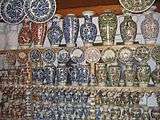 Korond pottery
Korond pottery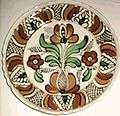 Korond plate
Korond plate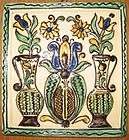 Stove tile
Stove tile
References
- "Populaţia stabilă pe judeţe, municipii, oraşe şi localităti componenete la RPL_2011" (in Romanian). National Institute of Statistics. Retrieved 4 February 2014.
- Tab8. Populaţia stabilă după etnie – judeţe, municipii, oraşe, comune, 2011 census results, Institutul Național de Statistică, accessed 20 February 2020.
